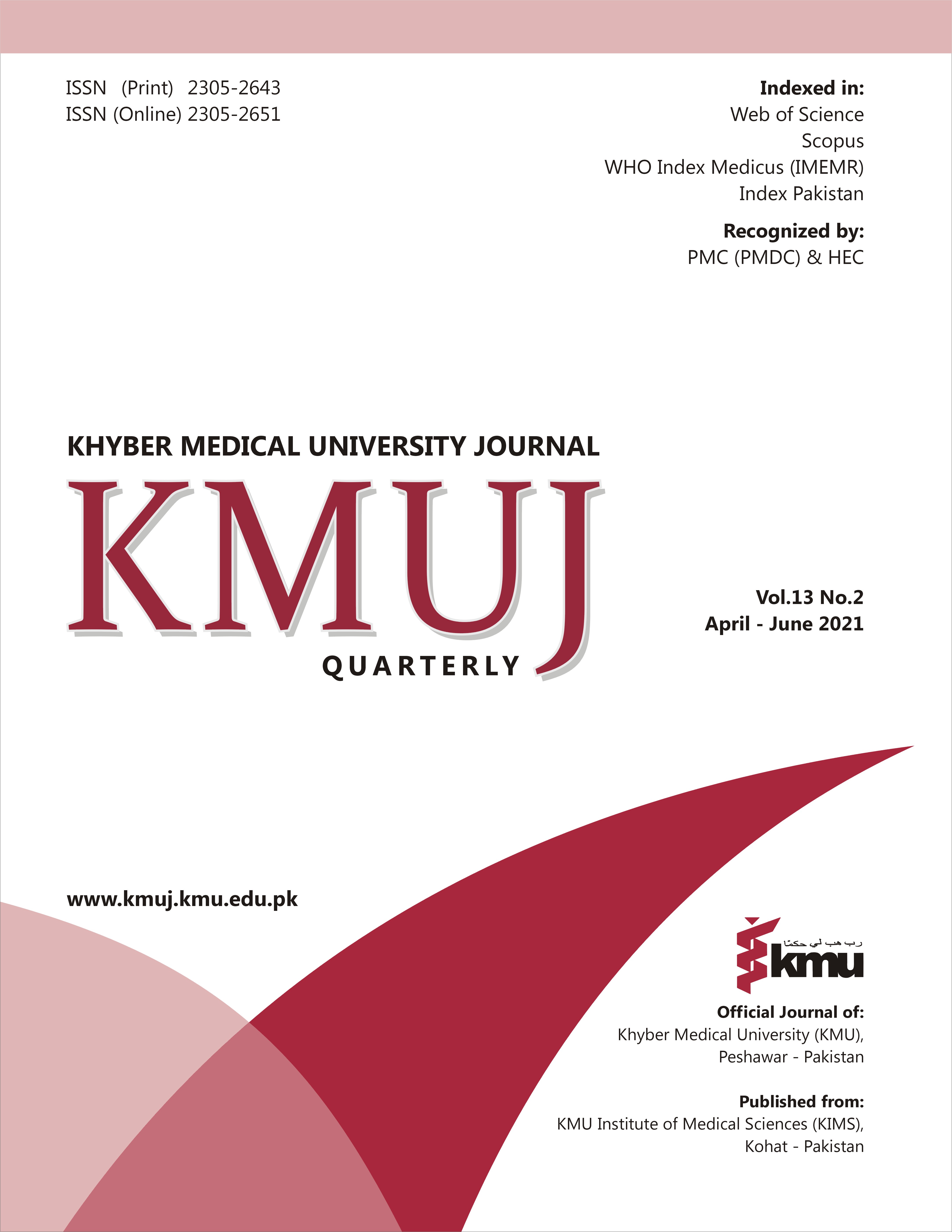CRY FOR HELP: PERCEPTIONS OF YOUNG ADULTS ON SUICIDE FROM NORTHERN PAKISTAN
Main Article Content
Abstract
OBJECTIVE: To examine the perceptions of suicide among a sample of adolescents from Gilgit-Baltistan and Chitral (GBC), a northern province of Pakistan.
METHODS: A qualitative, descriptive, exploratory design was employed to study the phenomenon by examining secondary data from an asynchronous, online student discussion forum at a University in Karachi. All the participants, originally from GBC, were enrolled from June-December 2019 using a purposive sampling technique. based on their experiences of losing a loved one (adolescent sibling or cousin or a friend) because of suicide. The narratives were content analyzed using Creswell framework resulting categories and an overarching theme. Study was approved by ethical committee of university. Pseudonyms were assigned to ensure anonymity and confidentiality of the participants.
RESULTS: Out of 10 participants, 8 were females and 2 were males aged 18-20 years. Participants shared their perceptions/experiences about suicide among adolescents in GBC, probable root causes of suicide and recommendation/suggestions in context of GBC. The analysis revealed an overarching theme “cry for help”, which was further divided into five categories including: (i) cultural norms; (ii) parents as a whistle for the rat race; (iii) psychological issues; (iv) seeking mental help - a challenge; and (v) how can I be helped?
CONCLUSION: Study findings provided insights into factors leading to suicide among young adults in GBC region. The contributing factors highlight the need to develop infrastructure to increase accessibility to healthcare centers, and predominantly access to mental healthcare workers for undertaking risk assessment, and managing the cases promptly is needed.
Article Details
Work published in KMUJ is licensed under a
Creative Commons Attribution 4.0 License
Authors are permitted and encouraged to post their work online (e.g., in institutional repositories or on their website) prior to and during the submission process, as it can lead to productive exchanges, as well as earlier and greater citation of published work.
(e.g., in institutional repositories or on their website) prior to and during the submission process, as it can lead to productive exchanges, as well as earlier and greater citation of published work.
References
World Health Organization (WHO). Suicide in the world: global health estimates. 2019. (Accessed on: November 28, 2020). Available from URL: https://www.who.int/publications/i/item/suicide-in-the-world
Bachmann, S. Epidemiology of suicide and the psychiatric perspective. Int J Environ Res Public Health, 2018;15(7):14-25. https://doi.org/10.3390/ijerph15071425
Jordans MJ, Kaufman A, Brenman NF, Adhikari RP, Luitel NP, Tol WA, et al. Suicide in South Asia: a scoping review. BMC Psychiatry 2014;14(1):358-64. https://doi.org/10.1186/s12888-014-0358-9
Khan MM, Reza H. The pattern of suicide in Pakistan. Crisis 2000;21(1):31-35. https://doi.org/10.1027//0227-5910.21.1.31
Anjum A, Ali TS, Pradhan NA, Khan M, Karmaliani R. Perceptions of stakeholders about the role of health system in suicide prevention in Ghizer, Gilgit-Baltistan, Pakistan. BMC Public Health 2020;20:991. https://doi.org/10.1186/s12889-020-09081-x
Dad AM. Why commit suicide, when we have one life to live. Pamir Times, March 6, 2018. [Accessed on October 01, 2020]. Available from URL: https://pamirtimes.net/2018/03/06/why-to-commit-suicide-when-we-will-live-only-once/
Rahnuma B, Fangtong J, Khan MA, Saddique K, Ahmad I. Causes of Suicide in Gilgit-Baltistan Region. Eur Acad Res 2017;8(5):4040-51.
Khan MM, Ahmed A, Khan SR. Female suicide rates in Ghizer, Pakistan. Suicide Life Threat Behav 2009;39(2):227-30. https://doi.org/10.1521/suli.2009.39.2.227
Sher S, Dinar H. Ethnography of suicide: a tale of female suicides in district Ghizer, Gilgit Baltistan. J Soc Sci 2010;1(6):207-10.
Muneeba S. A Qualitative Analysis of Suicides Committed by the Students in Pakistan. Pak J Med Res 2019;58:35-40.
Agerbo E, Sterne J, Gunnell D. Combining individual and ecological data to determine compositional and contextual socio-economic risk factors for suicide. Soc Sci Med 2007;64(2):451-61. https://doi.org/10.1016/j.socscimed.2006.08.043
Shain B. Suicide and suicide attempts in adolescents. Pediatrics 2016;138(1):e20161420. https://doi.org/10.1542/peds.2016-1420
Naveed S, Qadir TF, Afzaal T, Waqas A. Suicide and Its Legal Implications in Pakistan: A Literature Review. Cureus 2017;9(9):e1665. DOI:10.7759/cureus.1665
Donath C, Graessel E, Baier D, Bleich S, Hillemacher T. Is parenting style a predictor of suicide attempts in a representative sample of adolescents? BMC Pediatrics 2014;14(1):113. https://doi.org/10.1186/1471-2431-14-113
Yousefia S, Far AS, Abdolahian E. Parenting stress and parenting styles in mothers of ADHD with mothers of normal children. Procedia Soc Behav Sci 2011;30:1666-71. https://doi.org/10.1016/j.sbspro.2011.10.323
Cherry K. The effects of authoritarian parenting on children. Accessed on: January 23, 2019. Available from URL: https://www.verywellmind.com/what-is-authoritarian-parenting-2794955C, 2018
Gould M, Munfakh J, Kleinman M, Lake A. National Suicide Prevention Lifeline: Enhancing Mental Health Care for Suicidal Individuals and Other People in Crisis. Suicide Life Threat Behav 2012,42(1):22-35. https://doi.org/10.1111/j.1943-278X.2011.00068.x
Ibrahim N, Amit N, Suen MWY. Psychological Factors as Predictors of Suicidal Ideation among Adolescents in Malaysia. PLoS One, 2014;9(10):e110670. https://doi.org/10.1371/journal.pone.0110670.
Shekhani SS, Perveen S, Akbar K, Bachani S, Khan MM. Suicide and deliberate self-harm in Pakistan: a scoping review. BMC Psychiatry 2018;18(1):44. https://doi.org/10.1186/s12888-017-1586-6
Smischney TM, Chrisler A, Villarruel FA. Risk Factors for Adolescent Suicide. Int J Med 2014;108(10):765-80.
Huver RME, Otten R, de Vries H, Engels RCME. Personality and parenting style in parents of adolescents. J Adolesc 2010;33(3):395-402. https://doi.org/10.1016/j.adolescence.2009.07.012
World Health Organization (WHO). National suicide prevention strategies: progress, examples and indicators, 2018. Accessed on: January 23, 2019. Available from URL: https://www.who.int/mental_health/suicide-prevention/national_strategies_2019/en/
Wardle H, McManus S. Suicidality and gambling among young adults in Great Britain: results from a cross-sectional online survey. Lancet Public Health 2021;6(1):e39-49. https://doi.org/10.1016/S2468-2667(20)30232-2
Khan MM, Mahmud S, Karim MS, Zaman M, Prince M. Case–control study of suicide in Karachi, Pakistan. Br J Psychiatry 2008;193(5):402-5. https://doi.org/10.1192/bjp.bp.107.042069
